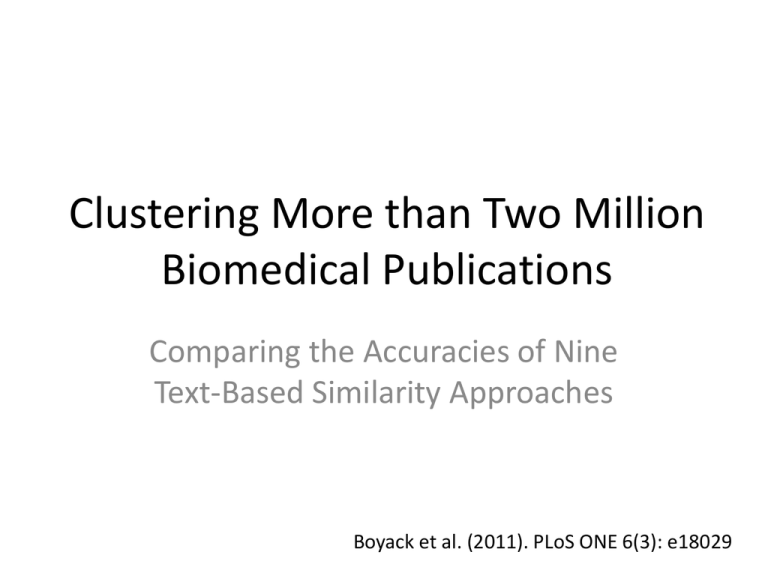Clustering More than Two Million Biomedical Publications
advertisement

Clustering More than Two Million Biomedical Publications Comparing the Accuracies of Nine Text-Based Similarity Approaches Boyack et al. (2011). PLoS ONE 6(3): e18029 Motivation • Compare different similarity measurements • Make use of biomedical data set • Process large corpus Procedures 1. define a corpus of documents 2. extract and pre-process the relevant textual information from the corpus 3. calculate pairwise document-document similarities using nine different similarity approaches 4. create similarity matrices keeping only the top-n similarities per document 5. cluster the documents based on this similarity matrix 6. assess each cluster solution using coherence and concentration metrics Data • To build a corpus with titles, abstracts, MeSH terms, and reference lists • Matched and combined data from the MEDLINE and Scopus (Elsevier) databases • The resulting set was then limited to those documents published from 2004-2008 that contained abstracts, at least five MeSH terms, and at least five references in their bibliographies • resulting in a corpus comprised of 2,153,769 unique scientific documents • Base matrix: word-document co-occurrence matrix Methods tf-idf • The tf–idf weight (term frequency–inverse document frequency) • A statistical measure used to evaluate how important a word is to a document in a collection or corpus • The importance increases proportionally to the number of times a word appears in the document but is offset by the frequency of the word in the corpus. tf-idf • • LSA • Latent semantic analysis • LSA • BM25 • Okapi BM25 • A ranking function that is widely used by search engines to rank matching documents according to their relevance to a query BM25 • SOM • Self-organizing map • A form of artificial neural network that generates a low-dimensional geometric model from high-dimensional data • SOM may be considered a nonlinear generalization of Principal components analysis (PCA). SOM 1. Randomize the map's nodes' weight vectors 2. Grab an input vector 3. Traverse each node in the map 1. Use Euclidean distance formula to find similarity between the input vector and the map's node's weight vector 2. Track the node that produces the smallest distance (this node is the best matching unit, BMU) 4. Update the nodes in the neighbourhood of BMU by pulling them closer to the input vector 1. Wv(t + 1) = Wv(t) + Θ(t)α(t)(D(t) - Wv(t)) 5. Increase t and repeat from 2 while t < λ Topic modeling • Three separate Gibbs-sampled topic models were learned at the following topic resolutions: T= 500, T= 1000 and T=2000 topics. • Dirichlet prior hyperparameter settings of b= 0.01 and a = 0.05N/(D.T) were used, where N is the total number of word tokens, D is the number of documents and T is the number of topics. Topic modeling • • PMRA • The PMRA ranking measure is used to calculate ‘Related Articles’ in the PubMed interface • The de facto standard • Proxy Similarity filtering • Reduce matrix size • Generate a top-n similarity file from each of the larger similarity matrices • n=15, each document thus contributes between 5 and 15 edges to the similarity file Clustering • DrL (now called OpenOrd) • A graph layout algorithm that calculates an (x,y) position for each document in a collection using an input set of weighted edges • http://gephi.org/ Evaluation • Textual coherence (Jensen-Shannon divergence) Evaluation • Concentration: a metric based on grant acknowledgements from MEDLINE, using a grant-to-article linkage dataset from a previous study • Results Results (cont.)











